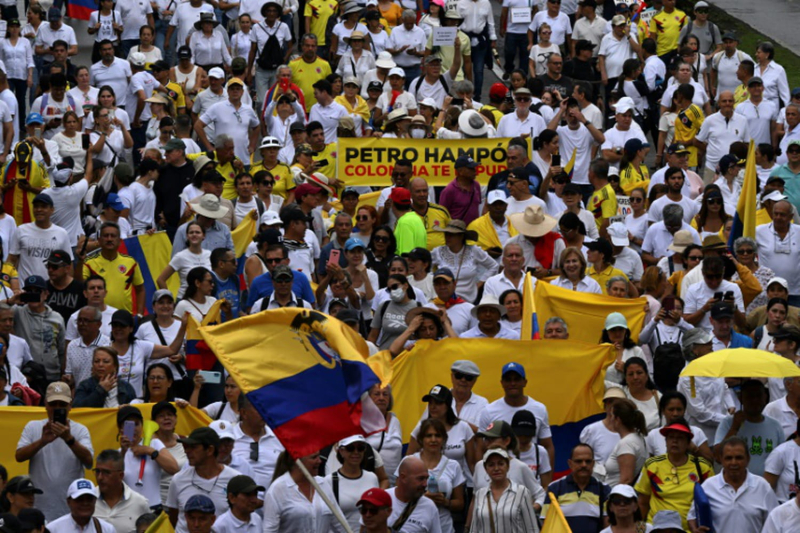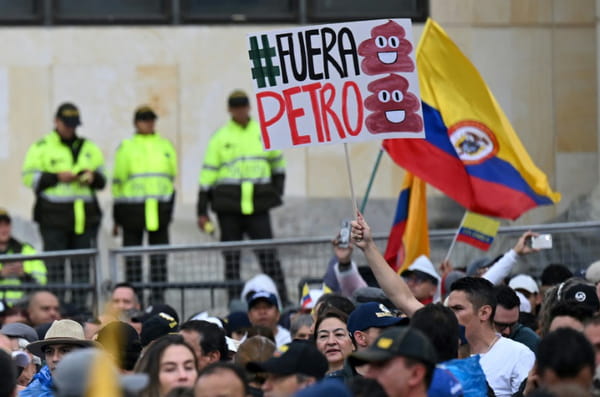Hundreds of thousands of people demonstrated Sunday in major cities of Colombia to protest against left-wing president Gustavo Petro, an unprecedented mobilization in the streets since his election in 2022. At the call of medical organizations, the opposition, centrist political forces and former allies who reject several reforms including its plan to nationalize health services, these demonstrators also protested against the violence which continues despite negotiations of peace with the armed groups. “I voted for change, for Petro, but we are still in the same situation. I demonstrate because I think that Colombia still has hope and I love my country,” Martha Estrada, a 64-year-old retiree, wearing a tricolor hat, told AFP in Bogota. Although the president did not speak directly, he posted on the X network the video of an old television satire, in which the “ruling class” protests. Demonstration against the left-wing Colombian government of Gustavo Petro, whose popularity is at its lowest point after twenty months in power, on April 21, 2024 in Cali © AFP – Joaquin Sarmiento This is not the first demonstration against Petro's government, but it is the first of such magnitude across the country. In the capital, despite the rain, tens of thousands of demonstrators headed towards Bolivar Square, close to the presidential headquarters, AFP noted. In Cali (southwest), Medellín (northwest), Barranquilla (north), Bucaramanga (northeast) and other cities, demonstrators joined the movement with Colombian flags, white T-shirts and a unanimous cry: “Out with Petro”! One of his reform projects, health, divided the country, because Mr. Petro began to implement implemented several axes on the administrative level despite the difficulties encountered in obtaining the support of Congress. – “march of the white coats” – The president wants to reduce the participation of the private sector in the provision of health services and, in recent days, he has intervened in several entities that serve as intermediaries between the state and hospitals, in order to control their budgets.< /p> Experts agree that the health care system is bankrupt and needs to be reformed, but some question how the government intends to do it.< /p> Demonstration against the left-wing Colombian government of Gustavo Petro, whose popularity is at its lowest point after twenty months in power, on April 21, 2024 in Bogota © AFP – Raul ARBOLEDA Under the name of “the white coat march”, the doctors expressed their “disagreement with the current management of the health system by the government”. According to Invamer, 56% of those surveyed in April rejected the fact that the government “intervenes in some EPS (health promotion entities) in Colombia to directly administer the system.” “I am here as a citizen, a doctor and a Colombian (…) As a doctor, we see the deterioration because there are no medicines to give to patients, because that patients delay receiving care,” says Dr. Julio Rivero, 35, in Bogota. In different cities, demonstrators carried banners referring to the insecurity and violence of rebels and drug traffickers in the countryside. “This man protects the guerrilla thugs more than the good people of this country. (…) It is time to unite so that he understands that we are not the powerful, but all the people, the working middle class, who need a change,” said Betty Ospina, a 67-year-old protester. The government's ambitious “total peace” policy, which aims to deactivate six decades of armed conflict, is suffering setbacks. Their critics reject the concessions obtained by armed groups in the peace negotiations, despite frequent violations of the agreement and few signs of willingness to lay down their arms. The negotiations with the rebels of the National Liberation Army (ELN) and the dissidents of the Revolutionary Armed Forces of Colombia (FARC) have experienced several crises due to assassinations, kidnappings and attacks against security forces. Seventy percent of Colombians believe the country's situation is “getting worse,” according to Invamer. M. Petro came to power in August 2020, becoming the first left-wing man to govern a country traditionally ruled by conservative elites. With a disapproval rating of 60%, according to the Invamer polling institute, the president has lost the support of political forces in Congress and in the streets. All rights of reproduction and representation reserved. © (2024) Agence France-Presse



